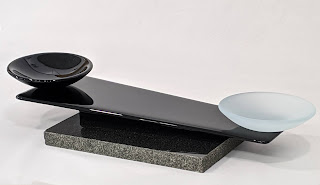Studio Tip: Powdered Frit
 |
| Fused glass mosaic with reactive glass |
One of the important considerations with glass powders is the reaction that can occur between different colors. Many glass colors contain copper or sulfur. These two chemical elements react with each other and can cause brown, black, or reddish color where they touch. With sheet glass, this can produce some nice effects, such as an outline around the outer edge of a design. This kind of reaction is shown in the example at the beginning of this post. Notice the dark outline around the yellow pieces where they touch the blue and also the red outline around the white (the white is reactive red glass).
 |
| Labels show glass color, element, and reaction strength |
When working with glass powder, however, because of the very fine particles that are being combined (and thus, touching), you can end up with a muddy-colored mess. To help avoid making some disheartening mistakes, one of the first things I did when I got my shipment of glass powders was to write on the top of each container the color, the chemical element, and the strength of the reaction (as specified by the manufacturer -- I use Spectrum System 96 glass).
While this isn't an earth-shattering idea, I think it is good studio practice. When I am creating my powder designs, I don't have to try to remember which glass contains copper or sulfur, nor do I have to go digging for the information through the sheets I've printed or search the manufacturer's web site for the information.
If controlled, reactions with powder can be used to great effect, just like with sheet glass. If uncontrolled, that lovely effect you expect to achieve by layering a thin layer of blue over a yellow powder base might lead to unexpected (and unwanted) results.
Hopefully, this quick studio tip will help you create beautiful fused glass pieces with powder, achieving the results you want.
Happy powder-flinging (as I like to call it!).
Dana
Resources:
Previous blog post about a great class given by Bullseye Glass maven Devon Willis. Includes links to both Bullseye's and Spectrum's reactive glass charts: http://jestersbaubles.blogspot.com/2014/01/bullseye-reactive-glass.html
Previous blog post about a crackle class with Crackle Master, Bob Leatherbarrow. Includes some resource links about the crackle technique http://jestersbaubles.blogspot.com/2014/11/fused-glass-crackle-technique-with-bob.html
Great video tutorials by Bullseye glass -- lots of great educational information for the fused glass artist, including two tutorials dedicated to glass reactions (subscription required, but well-worth the low fee, in my opinion). Click this image:
 |
| Fused glass crackle in the kiln |
- blue (copper)
- white (no reaction)
- yellow (sulfur)
- red (sulfur)
- orange (sulfur)

